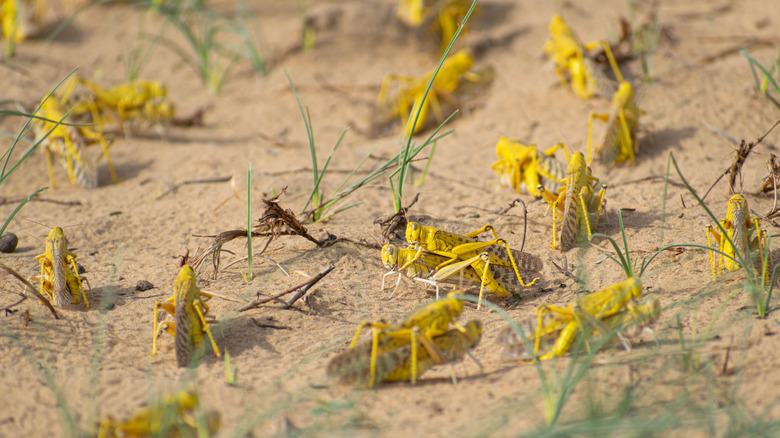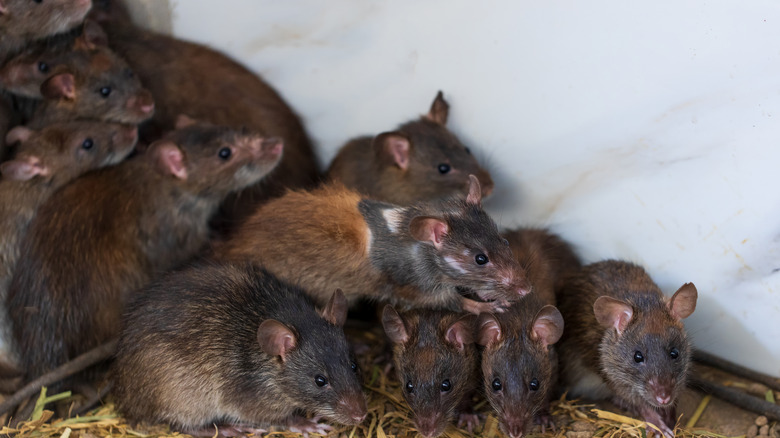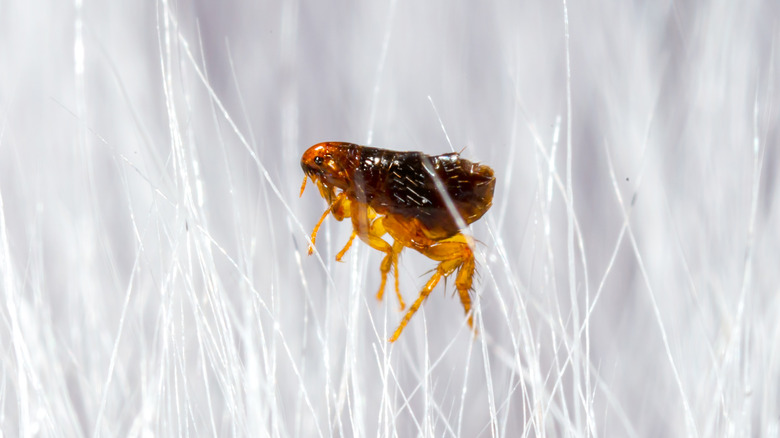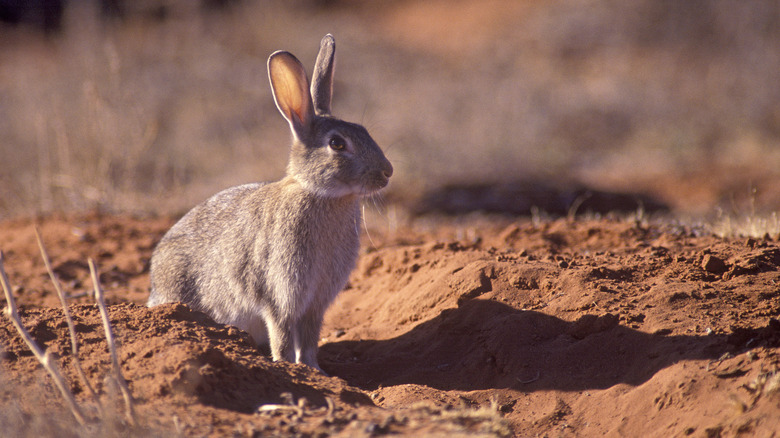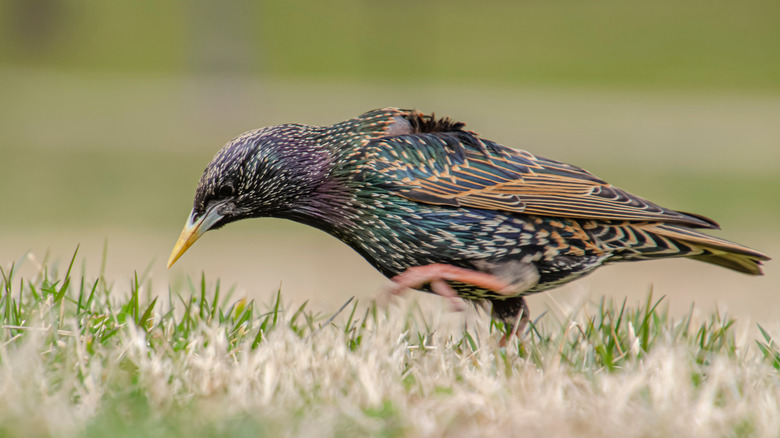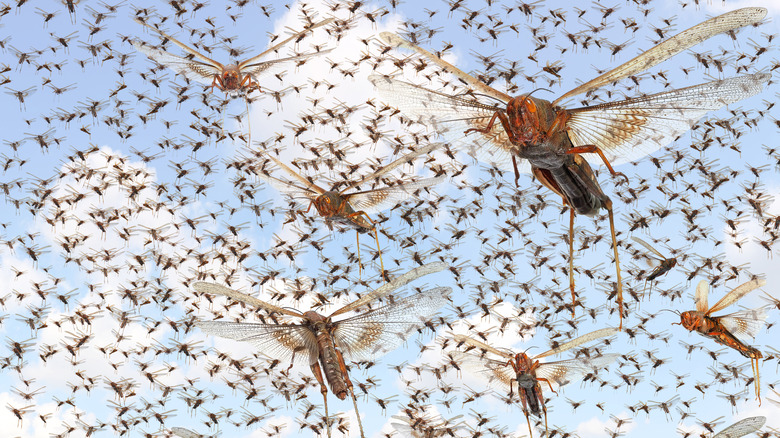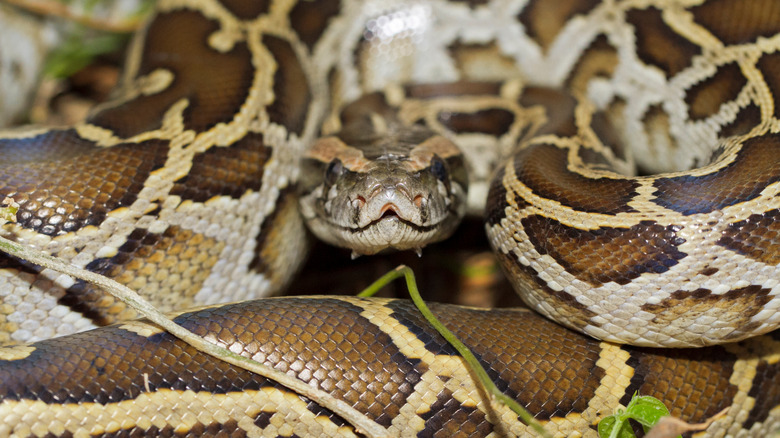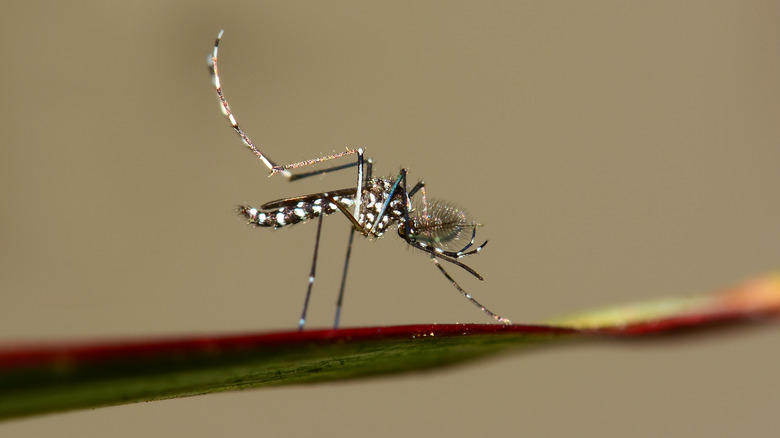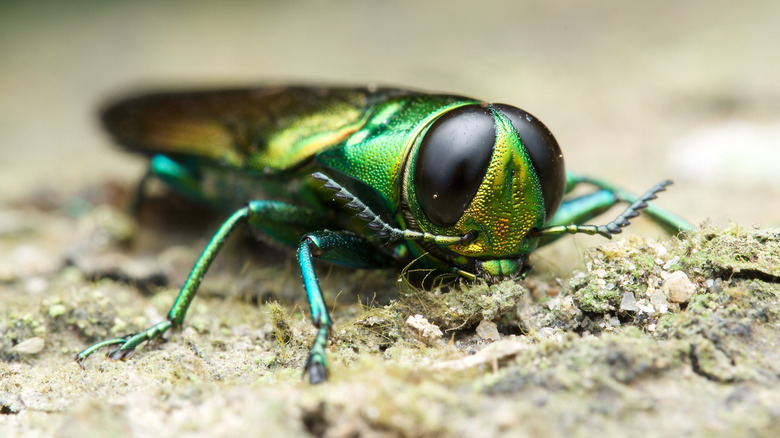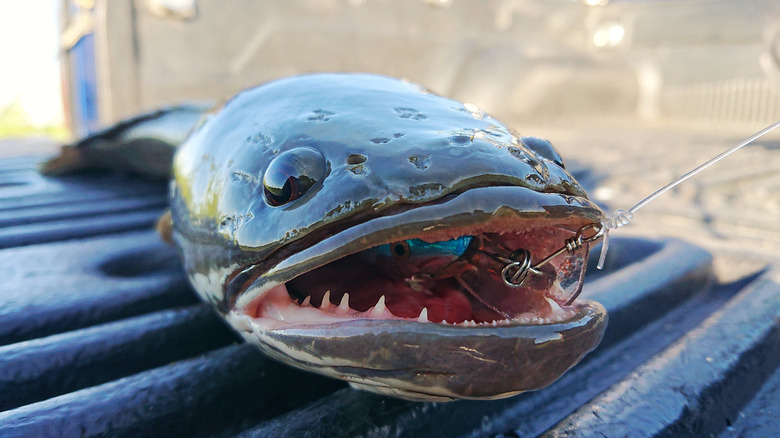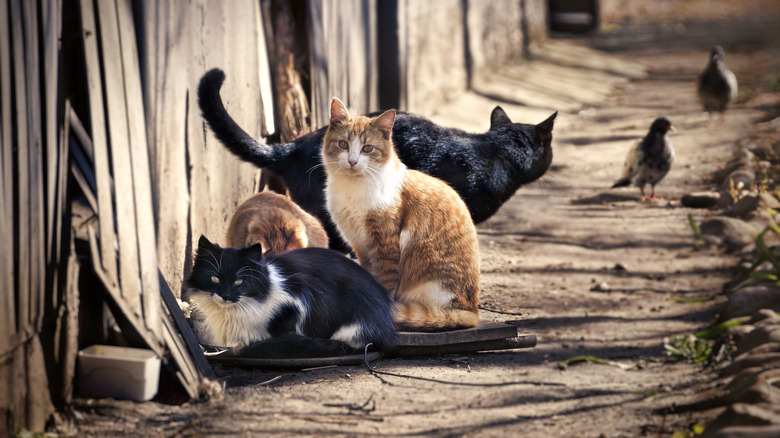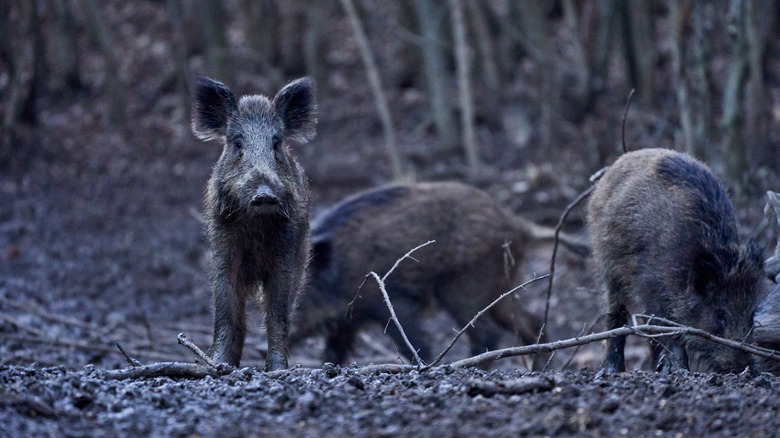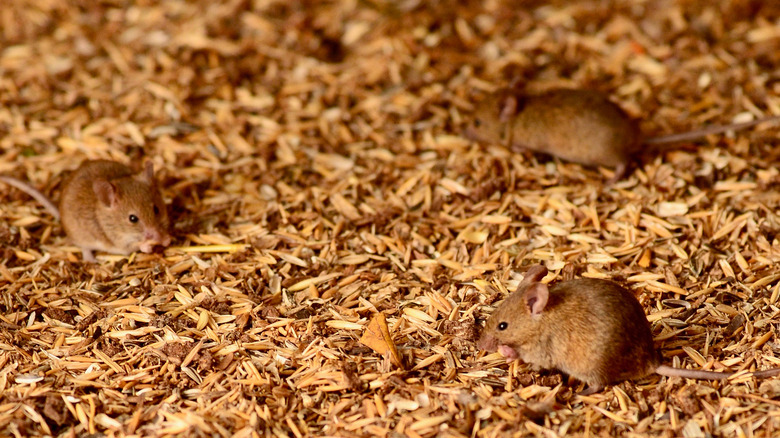The Worst Invasive Species Disasters In History
Equilibrium is of great importance when not only considering our lives but, more importantly, the wider world around us. Think of the devastation of global warming that's currently underway, human activity having greatly altered the equilibrium of the earth's climate. But looking beyond the slow but steady and calamitous effects of climate change, there are many examples of a specific region of the earth being ravaged not by warming temperatures, weather extremes, droughts, or tempests, but by the introduction of a species not native to the land.
According to the National Wildlife Federation, "An invasive species can be any kind of living organism — an amphibian ... plant, insect, fish, fungus, bacteria, or even an organism's seeds or eggs — that is not native to an ecosystem and causes harm." Historically, there are plenty of examples of an invasive species entering a new region through forces unrelated to human activity, but there are also myriad examples of an invasive species crisis directly caused by human activity, whether intentional or inadvertent.
Once an invasive species settles into its new environs, the results can be catastrophic for indigenous plants and animal life, to the agricultural and commercial productivity of an area, and to the quality of life for the people who call the area home. Here are 13 examples of invasive species disasters that will have you double-checking the hold of your ship for rats before calling on a foreign port. Or at least will have you wishing others had done so before you.
The black rat spread to every corner of the continent
All known "distinct lineages in the black rat's family tree [originate] from a different part of Asia," according to Science Daily, but this wildly successful species hardly stayed close to its ancestral home. Scientists estimate that black rat migration began some 20,000 years ago, with the rodents reaching the Middle East first, then quickly spreading into the regions of modern day Europe. Rats would not reach Australia or the Americas until thousands of years later when they hitched rides on sailing ships during the Age of Exploration, soon spreading out all across these new habitats as well.
Today, black rats can be found all over every continent on earth except for Antarctica. They are able to thrive in crowded cities, in suburbs, on farmland, and in forests, being highly adaptable. This adaptability comes largely because, according to the Australian Museum, "it eats just about anything." Black rats can cause major problems due to their tendency to spread disease (often via parasites they carry), to damage crops and infrastructure, and to out-compete local, indigenous species. That said, today black rats are so common in so many places that their presence is expected, not endemic, and their damage was largely done in centuries past. In some remote places, however, they remain a serious problem. "Few vertebrates are more problematic to island biota and human livelihoods than R. rattus," according to BioOne Complete.
Fleas spread Europe's devastating Black Death
Beyond a doubt fleas spread the yersinia pestis bacteria responsible for Bubonic Plague, also known as the Black Death, which has caused death and suffering many times throughout the course of history — and never worse than between the years 1346 to 1353, according to Science News for Students, when the sickness ravaged much of the world, killing millions. Modern experts estimate that fully one third of Europe's population was killed by the plague in those few short years. But while experts have long understood that the disease was transmitted via fleas, in recent years, just what — or, more accurately, who — was responsible for those fleas being spread so far and wide is being reevaluated.
While the fleas that infest rats will bite human hosts if no rodent host is handy, scientists have determined that rat fleas, Xenopsylla cheopis, will not target humans nearly aggressively enough to account for widespread outbreaks of plague. That dubious distinction goes to the type of flea that does target and infest humans, a pest known as Pulex irritans. It's almost certain that, in the cramped and unhygienic conditions of Medieval European towns, it was largely person-to-person contact that spread the Black Death, not rat-to-person contact.
Rabbits spread across an entire continent in less than half a century
The continent/country of Australia measures about 3 million square miles in area, according to Britannica. For some perspective, the state of Texas is about 268,597 square miles, according to Texas Proud, so you could fit about 11 of Texas into Australia. That should give you some perspective on just how rapidly wild rabbits propagated and spread all across Australia after their ill-conceived introduction. Yes, introduction: Humans brought rabbits to Australia and set them loose, thereby precipitating an invasive species disaster.
According to National Museum Australia, "In 1859 European wild rabbits were introduced into Australia so they could be hunted for sport." Within the next half century, rabbits spread across the entirety of the continent. "The proliferation of rabbits was the fastest of an introduced mammal anywhere in the world," and today there are an estimated 150 million wild rabbits roaming free across the continent — that's about five feral rabbits per Aussie, for the record (via World-o-Meter).
From that first release of wild rabbits, which involved just 13 animals and took place on Christmas Day of 1859, the effects the animals have had on Australia have been almost entirely ruinous, from "a collapse of indigenous plants and the native animal species that eat them" to "excessive grazing [causing] soil erosion," and more. The one boon is that rabbits are a source of cheap meat for many Aussies and were invaluable during the depression years of the 1930s.
Starlings are a menace all across North America
Today, there are an estimated 200 million European starlings in North America, according to Smithsonian Magazine, and as the name of the species suggests, they are hardly native to the Americas, hailing from across the pond. So what are these birds, which gather in flocks often numbering well into the thousands and found from Alaska to the south of Mexico, doing here? They were introduced to America in the year 1890 by a man named Eugene Schieffelin. In early March of that year, Schieffelin released five dozen starlings in New York City's Central Park as part of ongoing efforts of the American Acclimatization Society to introduce every bird mentioned in the works of Shakespeare to the United States.
So basically, these birds were brought to America as a lark, so to speak. But little fun would be the result. Highly successful in their new environs, starlings soon multiplied and migrated. The troubles they cause are many: "Starlings will bully other birds, kicking bluebirds, flickers and woodpeckers out of their nests. They can consume whole fields of wheat and transmit avian, animal, and human diseases." That and there is the simple matter of the mess flocks numbering into the thousands can leave behind.
Grasshoppers ravaged American farmland during the Great Depression
America was dealt a series of blows during the Great Depression years, and no area was hit harder than the Midwest. Already reeling from fallout of the financial market collapse of late 1929, in the 1930s drought conditions ravaged crops across much of the so-called American Heartland. Then, in the summer of 1931, according to History, an unprecedented swarm of grasshoppers descended on farmland from the Dakotas to Iowa, Nebraska, and beyond. "The July 1931 swarm was said to be so thick that it blocked out the sun and one could shovel the grasshoppers with a scoop. Cornstalks were eaten to the ground and fields left completely bare."
The insects wreaking the havoc were technically grasshoppers, but they had undergone a transformation into locusts, according to NPR. "Most of the time, locusts exist in their 'grasshopper phase' — they lead solitary lives, they're green and pretty unremarkable. ... But when environmental conditions are right — usually when there's a lot of rainfall and moisture — something dramatic happens." This dramatic something is a total shift on grasshopper behavior; they go from solitary to highly social, actively seeking close proximity with other locusts in a so-called "gregarious phase." They also physically change, growing larger, more active, and hungrier. The locust swarms of the 1930s were absolutely devastating. Fortunately, no such swarms have formed in America since, though they plague many other parts of the world to this day.
Burmese pythons are a menace to local wildlife in Florida
Burmese pythons routinely grow to a dozen feet or so in length, with some reported at nearly 20 feet in length. A snake of that size can easily kill and consume animals like deer, panthers, immature alligators, and, in short, all sorts of species native to Southern Florida — a region to which these fearsome snakes are not native but around which they have now spread far and wide, according to the U.S. Geological Survey. The Burmese python arrived in Florida as a result both of captive snakes escaping, as well as intentional (and foolhardy) release of the snakes. Currently numbering at least in the tens of thousands, according to estimates, these powerful constrictors now have a well-established breeding population in Florida. And there's little if any chance they will ever be eradicated from the area.
"The odds of eradicating an introduced population of reptiles once it has spread across a large area are very low," according to USGS reporting. "And with the Burmese python now distributed across more than a thousand square miles of southern Florida, including all of Everglades National Park and areas to the north such as Big Cypress National Preserve, the chances of eliminating the snake completely from the region is low." So hopefully, at the very least, these invasive snakes won't expand their habitat farther up into the American mainland.
The Asian Tiger Mosquito has spread across America
According to the BBC, the mosquito is the most dangerous animal on the planet, being responsible for the deaths of about three quarters of a million people every year due to their uncanny ability to spread diseases like malaria and dengue fever. Thus it was simply terrible news when a new breed of mosquito, the Asian Tiger Mosquito, arrived in the U.S. in the year 1985. According to the Illinois Department of Public Health, these mosquitos arrived by hitching a ride on imported tires, little pockets of water in the tires harboring their eggs.
In the years since, these mosquitoes have spread out across dozens of states. They are even more dangerous than non-invasive mosquito species due to their 24-hour-a-day activity. While many types of mosquitos are only highly active at dusk, Asian Tiger Mosquitos feed all day long, according to the UC Riverside Center for Invasive Species Research, and are even active at night. These insects "can survive in a broad range of climates and [have] spread rapidly from the point of first detection in the south-central United States," and are surely going to continue to spread and are here to stay.
The Emerald Ash Borer may well wipe out all American ash trees
First seen in Michigan less than two decades ago, in less than 20 years, one species of insect has multiplied into the tens of millions and is now so badly savaging huge swaths of American Ash trees that the species of tree may cease to exist in North America in the near future. According to the Emerald Ash Borer Information Network, This "exotic beetle ... was discovered in southeastern Michigan near Detroit in the summer of 2002 ... [the] Emerald Ash Borer probably arrived in the United States on solid wood packing material carried in cargo ships or airplanes originating in its native Asia." The beetle spread rapidly and was soon found in some three dozen states and more than half a dozen Canadian provinces.
"The adult beetles nibble on ash foliage but cause little damage [but] the larvae ... feed on the inner bark of ash trees, disrupting the tree's ability to transport water and nutrients," and soon kill the whole tree, according to the EAB Info Network. The loss of all ash trees would be a calamity for myriad sectors of the American economy, the wood being prized for use in furniture making, for use in baseball bats and hockey sticks, and in decorative architectural applications, as well as to make wooden utensils and food storage containers, according to the Hardwood Distributor's Association.
Snakehead fish are destroying the Chesapeake Bay
Snakehead fish are, objectively, rather terrifying. Not only do these long, lean fish have multiple sharp fang-like teeth in their jaws, but they can breathe air with their gills, surviving on land for up to four days and able to travel up to a quarter mile over land by wriggling and thrashing about, according to USGS. And if snakeheads were only extant in their native Asian and African environs (there are two distinct types of the fish, the Asian Channa variety and the African Parachanna, for reference), then they would hardly be worth remarking on, fearsomeness aside, beyond their value as a food source.
But currently, these fish are wreaking havoc on parts of the eastern seaboard, having invaded the fragile waters of the Chesapeake Bay and now spreading out up and down the coast, already seen in many freshwater areas from Virginia to Delaware. According to USGS, "During all of their life stages, snakehead fish compete with native species for food and habitat. A major concern is that snakeheads might out-compete (and eventually displace) important native or other established predatory fish that share the same habitat. As adults, snakeheads can be voracious predators. Should snakeheads become established in North American ecosystems, their predatory behavior could also drastically disrupt food webs and ecological conditions, thus forever changing native aquatic systems by modifying the array of native species."
Feral cats are an absolute menace to wildlife in America
Sure, one stray cat may look charming and harmless and such from a distance, but feral cats are an absolute disaster of an invasive species when looked at as a whole. According to NOLA, experts estimate that there are between 60 and 160 million feral cats in the U.S. Stray, wild cats are known to be responsible for the extinction of more than 60 species of animal and kill up to 3.7 billion birds and some 6.9 million mammals annually.
Those statistics alone lay bare why wild cats are such an issue in America, but they don't even tell the whole of the story. Many of the billions of animals feral cats kill each year they slay for mere enjoyment, leaving the dead body of the hapless animal behind. This can in turn serve as a food source for other pests, like rats, or else lead to the spread of bacteria as the discarded carcass breaks down. And what's worse yet is that many of the animals feral cats kill would themselves have consumed a still deadlier creature: the mosquito. Every bird or bat a cat kills may leave dozens or even hundreds of mosquitos alive and waiting to bite a human.
Feral swine have spread to nearly three dozen states
There have been wild pigs in America for almost as long as there have been Europeans showing up here. According to the Animal and Plant Health Inspection Service of the USDA, "Free-range livestock management practices and escapes from enclosures led to the first establishment of feral swine populations within the United States" — this dating back to the 16th century. Then, as recently as the 1990s, "the Eurasian or Russian wild boar was introduced into parts of the United States for the purpose of sport hunting. Today, feral swine are a combination of escaped domestic pigs, Eurasian wild boars, and hybrids of the two."
The problem is that these wild pigs are now experiencing explosive population growth, having spread out across some three dozen states and with numbers calculated at 6 million and growing. The National Invasive Species Information Center states that wild hogs damage indigenous plants and crops and compete with native species and are known to be able to spread certain diseases as well, with sicknesses they carry creating a risk for native wild species, for livestock, and for humans.
Australia is in the midst of an absolute plague of mice
Australia is in the midst of a plague of mice, something the continent experiences about once a decade, according to The New York Times – though the 2021 glut of rodents is nearly unprecedented. Since first being introduced to Australia in the late 1700s, according to Plos One, mice have spread across much of the nation, though usually they remain in manageable numbers. Heavy rains last year led to a bountiful harvest this year, and as farmers' stores filled with more grain than usual, so too did the mouse population explode in numbers.
An adult female mouse can birth six to 10 offspring as often as every three to four weeks, thus it's little wonder why there can so quickly be a population surge when food is plentiful. The current surge has seen mice devastating crops and stored grains, infesting homes, businesses, farming facilities, and more, and creating highly unpleasant and unsanitary conditions all over the nation.
Are humans the worst invasive species of all time?
Human beings are perfectly capable of living in harmony with nature, at least for a time. Our species caused no damage to the planet for the first couple hundred thousand years of our existence, and right up to the present there are still some examples of isolated groups living in a truly sustainable, eco-friendly manner. But writ large, humans are just terrible for every square inch of this planet. And according to Smithsonian Magazine, humans check just about every box for rating as an invasive species — being widespread, non-native to most lands, and usually having adverse effects on settled places.
From plastic found at the depths of the ocean to increased greenhouse gasses in the air to forests slashed and burned to fisheries depleted if not outright ruined, humans are arguably the worst invasive species ever. Still not convinced? Then think of it through this lens: who is responsible for the feral pigs or Asian Tiger Mosquitos in America, the rats in Europe, or the rabbits in Australia? Human beings in every case and in so many more, of course. So even if not the worst, humans are wretched enablers.
